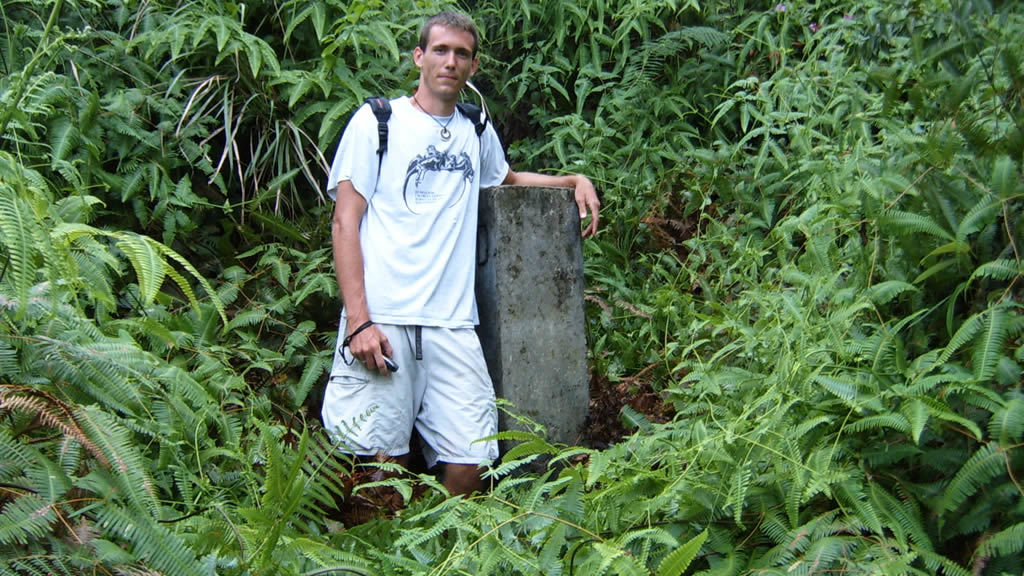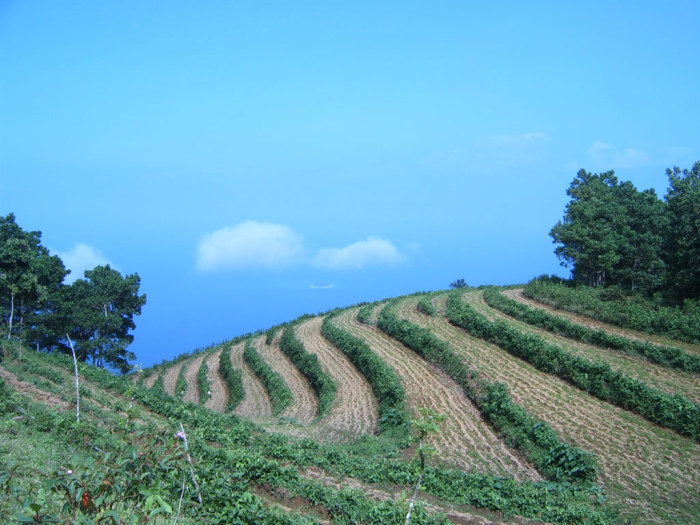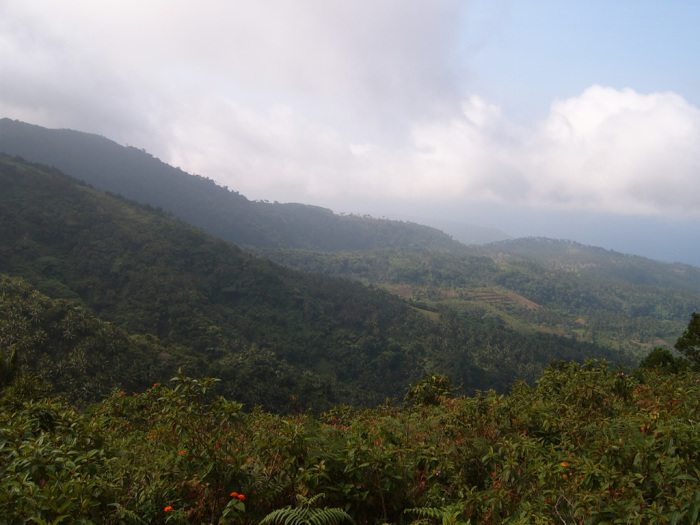The last entry is always the hardest to write I think. It’s easy enough to prattle on for weeks about this and that, but when forced to commit yourself to an opinion or two and draw some concrete conclusions, well, the words come more slowly.
My final act on the island of Camiguin was to head back to San Isidro and GPS the CBFM site with Jorge and Nicoles the surveyor. Originally Jorge, Nicoles, and I were scheduled to begin work on Monday, March 20th. However, Nicoles’ brother died and we delayed until Wednesday the 22nd while they buried him. Then, as it turned out, there was some trouble with the actual burying him part (“I’m feeling better…” “No you’re not!”) so it wasn’t until Thursday that Jorge and I finally met up with Nicoles on the mountain. Nicoles is the head of a Department of Environment and Natural Resources land survey team, and we joined them for the morning’s work. The plan was that Jorge and I would follow while they slowly surveyed their own project and when we passed near markers of interest to me they would point them out. In the meantime I got an excellent firsthand reminder of the wonders of government efficiency.
Nicoles and his crew use the industry standard laser and two reflector system. What sets these fellows apart is the man-power this “requires.” In the real world, surveying a given landscape with a laser unit and reflectors is routinely done with 3 people. One to operate the unit, one to hold the reflector for the forward shot, and one to hold the reflector for the backsight shot. You can even cut that crew down to only 2, one to operate and one to work the reflectors, although it makes it far less efficient. For the DENR, it apparently requires no less than FIVE people. Mind you I had several hours to kill while these guys did their thing, so I went all Jane Goodall on them and broke down the roles of the FIVE workers from most to least seniority:
#1 – The Boss
This was Nicoles’ position. The Boss is the most senior member of the crew, and as far as I can tell his only job is to find shady spots near each survey point… and then stand in them. I’m dead serious.
#2 – The Backsight Guy
The Backsight Guy only has to work slightly harder than The Boss. His job is to hold the reflector up back at the previously shot location for a reference point. He need do nothing until #3 is ready to shoot, then stand still for 5 seconds, at which point he can again return to his shady spot. He also is always the last man on the trail, which means he never needs to bushwhack or watch his step as the trail is well beaten by the time he travels it. He is a bit lonely though.
#3 – The Laser Operator
While he isn’t the most senior member of the crew, essentially the success or failure of any given day is in his hands. His competence on the laser unit is what dictates the quality of the maps.
#4 – The Forward Sight Guy
Now we’re getting towards the bottom of the totem pole. This fellow holds the forward reflector, so he is always first through the bush, which means his bolo gets *a lot* of work. He also rarely has a chance to duck into the shade, so he spends most of the day sweating and chopping through the brush.
#5 – The Mule
The last member of the crew, this fellow is quite literally the mule. His only stated job is to carry the laser unit inside its protective case on his back between stations. However, as the rookie on the crew, he is required to do anything anyone else asks of him, a privilege that is not seldom used. Here is an excellent picture of him dutifully holding an umbrella over #3’s head to create a bit of shade.
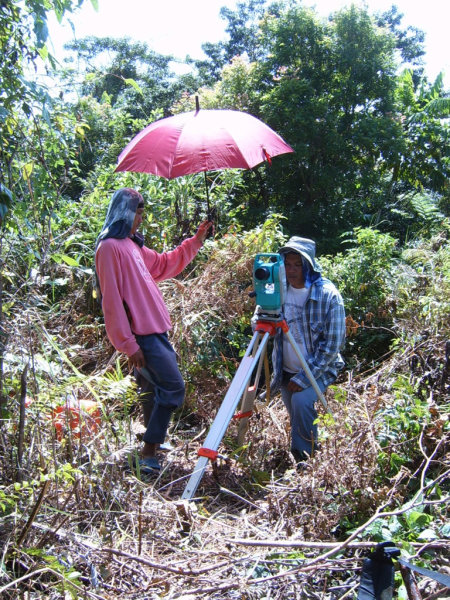
As the morning wore on and the sun climbed higher in the sky, things really started to heat up at our perch under a cloudless sky at 3,000ft and a latitude of only 9 degrees. By 10:30 I was starting to get concerned because I had yet to see any indication that these jokers had brought water with them and we were a good hour’s hike from the nearest water source I could think of. After so many weeks in the Philippines I was embarrassed when we finally stopped for a drink and I realized my oversight. Do you bother lugging liters of water around with you just adding to your pack-weight, or do you just send #5 up the nearest coco tree for a half-dozen coconuts full of cool, refreshing coco-water? Yeah, I was pretty pissed I didn’t think of that one…
So we each drank our fill from a coconut, and then, once more proving the extreme resourcefulness these people exhibit with all things coco, #5 used his bolo to turn a few strips of the husk into scoops with which we extracted the soft fresh coco meat. Standing in a row enjoying our break from left to right are Nicoles, #4, and #3, with #2 in the background. In #4 & #3’s hands you can see both the improvised scoops and the soft coco meat.
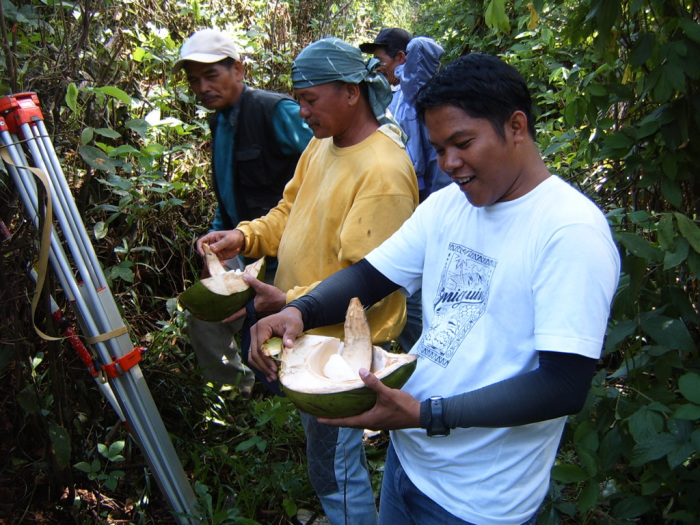
The CBFM site itself is a fascinating area. At times you find yourself standing in the middle of a grassy field, at other times you quite literally are hiking through the jungle
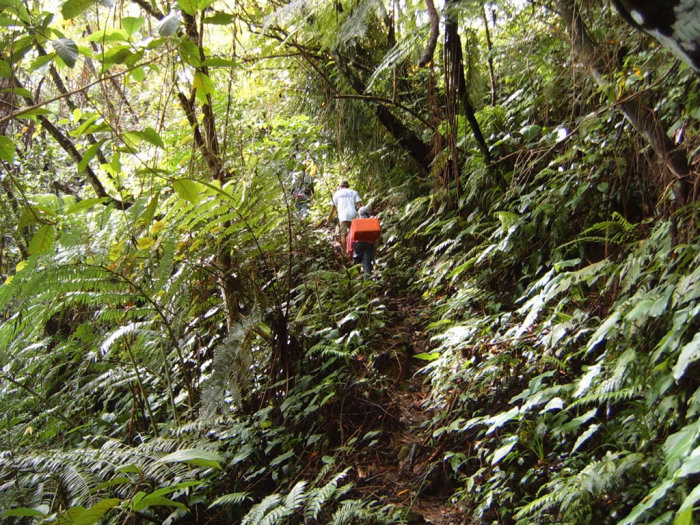
You can see Jorge and #5 with his pack in that one. And then there are the cultivated sections, the inhabitants having long since learned the importance of contour cultivation to maintain slope integrity.
The survey team finished their allotted work for the day by 1pm and then settled in for lunch and rum at the eco-lodge. After resting a bit to let lunch settle, Jorge and I set back out with Nicoles and #5 to get the rest of the GPS points we hadn’t passed in the morning. We bagged a quick half-dozen or so in an hour, no longer having to wait while the laser was setup, operated, broken down, and moved to the next spot. Before we realized it, 3pm had rolled around and we only had one marker left, although it was way, way back up in the jungle. We found the near-completely overgrown trail back to the marker and slowly began making our way up the mountain and deep into the forest, #5 having to use his bolo every single step. For 30 minutes we slowly picked our way through dense forests and patches of grass that extended well over my head. When we popped out onto a small ridge with a view down into a valley on either side, I snapped this picture of the group.
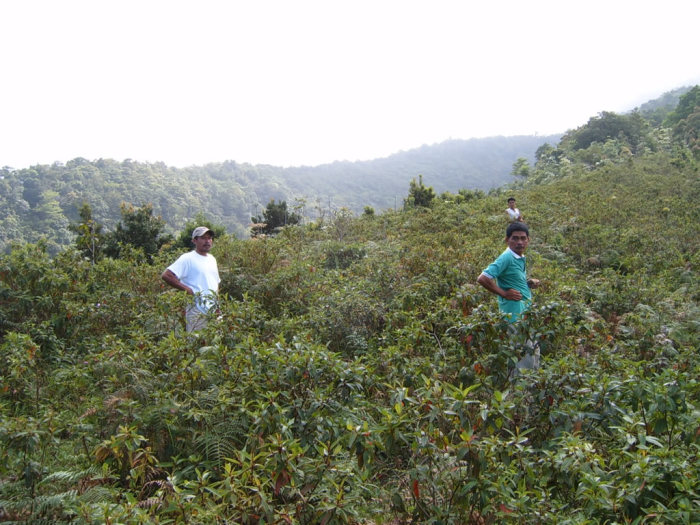
We were soon back in the depths of the forest though and long after I had given us up for lost, Nicoles declared us at “the spot.” He explained we were looking for a 6ft high concrete marker. In any ordinary situation this would have been simply a matter of looking in all directions – concrete obelisks tend to stand out in a forest – but this clearing was a little bit different. You see, it was overgrown with ferns to a densely packed height of 6 to 8ft, completely concealing a man, much less a stone pillar.
#5’s bolo was useless, so he sheathed it, limbered up for a moment, and then quite literally stage-dove onto the tops of the ferns. Jorge quickly followed suit, and I right behind him, the three of us half swimming, half crawling in different directions over this fern carpet in search of the pillar. It was #5 who ended up uncovering it, and then hacking the ferns back enough that I could stand beside it and mark it. Jorge took the picture and took it well.
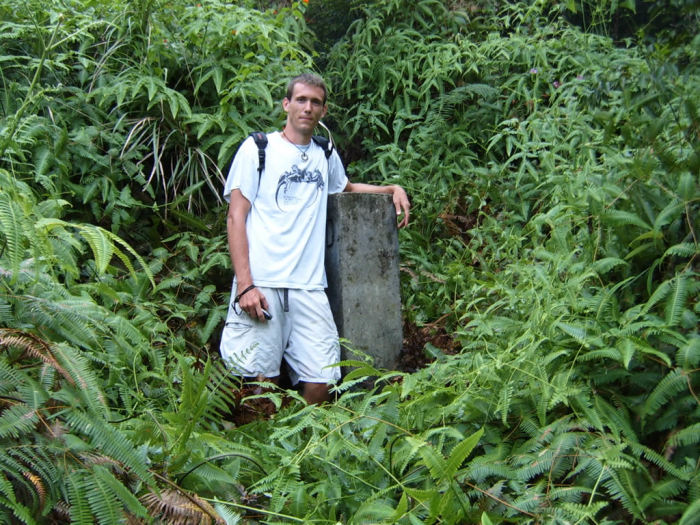
That, dear readers, is the final action of my master’s field work. Lemme tell yah, it felt pretty damn good.
The trip back down the mountain to the base camp was quick and uneventful, although we were pleased to discover that while we were swimming laps through our ferns the clouds had descended to envelope our part of the mountain. This is us crossing the previously photographed ridge.
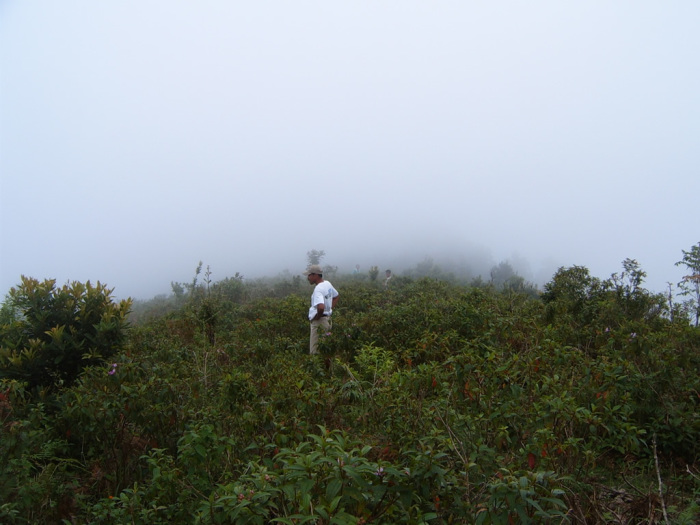
As you can see, the view is just *slightly* diminished.
That night Jorge, his wife Karina, the immediate neighbors, a few DENR boys, and myself had a raucous going-away party. The following morning Jorge walked with me down to the island highway, and we shook hands as my jeepney pulled up, I hopped aboard, and waved goodbye as it pulled away. I don’t know if I’ll ever see the Galua’s in person again, but I left them a pretty good souvenir of our time together – when I left they had just begun Karina’s long wished-for dream of tiling their kitchen, paid for by all of my rent money!
My last Camiguin-related picture is a good one I think. Can you guess what my preferred type of footwear was during my field work? Ha.
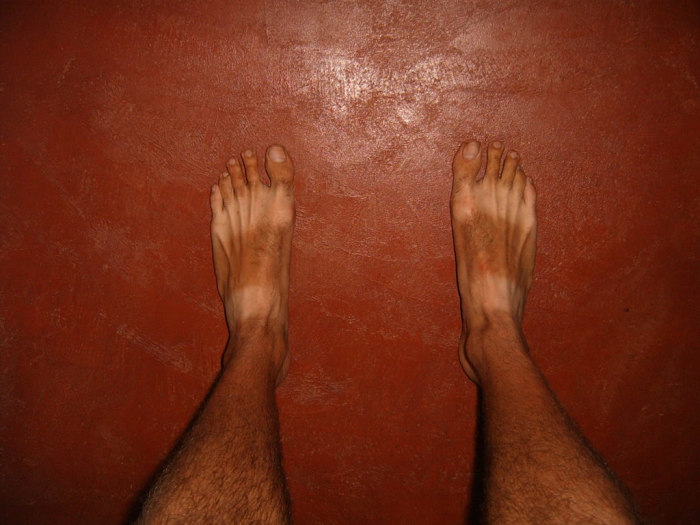
On March 29th I left the island for good, spent a day resting in Cagayan de Oro, and flew on to Manila on the 31st. I holed up in a hotel downtown for two days, and then rejoined my Dutch friends on Sunday afternoon. They’re still boppin’ around to different eco-tourism spots in the Philippines and were generous enough to offer me the use of their rented apartment for the first week of April. We overlapped for Sunday night – they left early Monday morning for another remote location in the islands – and I got a chance to meet and have dinner with their boyfriends who had just arrived for a visit. Good food and better wine set the scene for some great merriment.
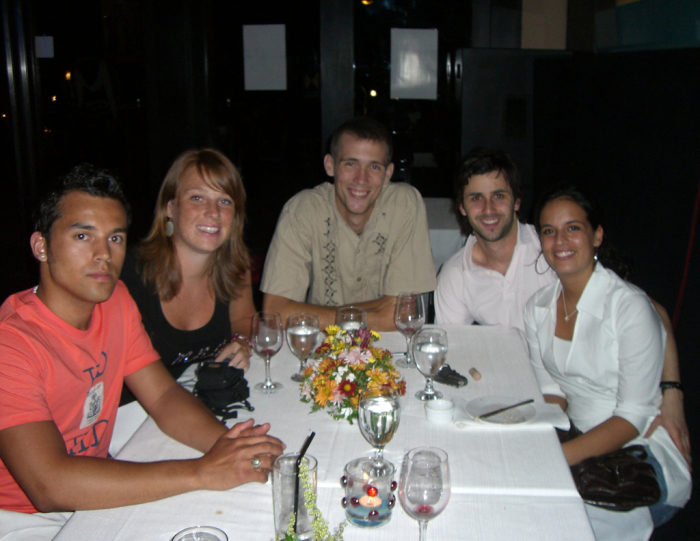
Celeste and her boyfriend are on the right, I’m afraid I never got the guy’s name, but we hit it off right from the start. He’s a product engineer for a small Austrian golf company. Nicole and her boyfriend Leroy are on the left. Leroy is a rookie member of Holland’s drug and terrorism interdiction unit, which I guess is why he didn’t smile for the picture – his work is much too serious.
And since then I’ve just been passing the days here in the apartment, venturing out only occasionally to have some laundry done and visit an internet cafe. I’m staying in a cozy apartment in Quezon City, perhaps 30min by taxi from Metro Manila. For those who don’t know, there are ~160 million residents in the Philippines and through some of the worst urban planning in the world, ~80 million of those have settled either in Metro Manila or in the slums and ghettos that radiate outwards from it for unending miles. To be outside is to virtually guarantee oneself bloodshot eyes and sore lungs from the auto exhaust. It’s pretty horrible and I am more than ready to get out of this urban hell and back to Japan. Don’t get me wrong, Japan is no shining example of environmental excellence to be held high and praised, but they’ve got the science of urban life *down* and can pack far more people into far less space with vastly less pain or pollution to all involved.
So, what do I think after two months of living and traveling through a third world country? Well I can draw one conclusion immediately: the life of someone living in urban poverty is far, far worse than that of someone living in rural poverty.
The irony there, of course, is that poor people the world over see urban centers as places where they can remake their lives. This to a large degree is why so many people have settled in and around Manila. Indeed Manila is where everything happens in this country, there’s no arguing that, but for every 1 person who moves here and makes it there are at least 1,000 who don’t.
To be impoverished in the country-side means to have a small bamboo house, to wear tattered clothing, and to not have a TV. You still farm though, and most importantly you still eat. To be impoverished in the city is to sleep under makeshift cardboard shelters in empty lots, to dig through garbage for food, to have nothing. Worse yet, it is the poor of the urban centers who are succumbing to the Philippines’ newest affliction, “shabu.” Back in the U.S., we know it as “meth.” In a country with terrible economic disparities, methamphetamine has taken root among the lowest rungs of society and is running rampant through the cities.
Those were all fairly predictable realities for a developing country though, so I’ll share with you something that surprised me. The Philippines is nearly 98% Roman Catholic. Jesus and Mary are everywhere, although Joseph seems to be almost forgotten. Bible verse scrawled on walls is perhaps the most common type of graffiti. Jeepney’s are commonly plastered with the phrase “God’s Gift” in big neon letters. Every major newspaper carries a section with a daily bible verse and analysis. Perhaps most extreme, divorce is illegal here. If your marriage falls apart you simply have to stop living together and go your separate ways. You cannot ever remarry because you are never allowed to divorce. This is turn has created a statistically significant portion of the population that has a live-in partner and children out of wedlock. [I regret I have yet to get a clear explanation of abortion laws here and I won’t resort to conjecture so I can’t include them]
None of those are the surprising part though. My surprise came at the realization that despite all of those examples of the extreme influence Catholicism has on this culture and on this government, gays by and large have broken through to mainstream culture. In a country where government and orthodox Catholicism are such tight bedfellows that divorce is illegal, they had their own equivalent to Dharma & Greg on TV last year. Now Manila isn’t San Francisco, and anyone who is “out” is likely to face a hail of criticism and bias, but people are talking about homosexuality, on TV, in the newspapers, and on the streets.
How did this happen in such a religiously conservative country? Well there are gay rights groups here in the Philippines, but from the little I’ve seen they are fledgling and disorganized. Really the only explanation is that the Philippines’ beginning to accept homosexuality is a ripple effect from their insatiable consumption of American culture. It is very difficult to give your people access to another country’s culture but then censure the bits you don’t like, just ask China.
Now I have never been a direct participant of the ongoing battle in America over gay rights, but I have watched the proceedings closely, and to me it’s an interesting thought to wonder if people on both sides of the issue ever stop to realize that their efforts are changing lives and attitudes not only in America, but in countries that look to us as well…
I bitched and moaned a good deal about not having hot water for two months and it’s really not that bad. Truth be told you get over it after about a week. What it does change though is the way you approach time spent in the bathroom.
For myself, and I expect for many others, a hot shower in the morning is a pleasurable experience. The same can be said for one after a workout or a hard day. One need only look to the contents of the modern American shower to see my point. A whole industry of added comforts has sprung up around the hot shower. One can buy a myriad of sponges, waterproof radios, even that dual-shower head sold in airline catalogues so couples can enjoy a shower together.
Cold water does not lend itself to such amenities. When that first bucket of water hits you in the face you’re not looking forward to trying out your new louffa together with your beaded bodywash, you’re not pumped up to belt out another Top 40 hit alongside your shower radio, and you’re sure as hell not ready to be intimate with your significant other under a steady stream of water. You just want to get soaped up, get rinsed, and get the fuck out. It’s a different experience, and frankly I missed the old way very very much, that’s all I’m saying.
The Philippines is known for it’s friendly people, a reputation I will not slander. Just for the record though, I would like to clarify the difference between pleasant friendliness and being an irritating asshole.
It’s quite simple really. If you are approaching a foreign person on the street, sidewalk, whatever and say hello, or as they say here “Hi friend!” – that is polite and has probably made the foreigner feel welcome and happy. If you see a foreign person on the street, sidewalk, whatever, and by the time you pull the beer bottle out of your face and lay down your cigarette they’ve walked 20 or 30 yds past you and you yell out “Hey!” or “Friend!” or “Mister!” at the top of your lungs – this is called being an asshole.
In most cultures, when someone you do not know yells to you from a distance it is because they have a very good reason for wanting your attention. Maybe you’ve dropped something, maybe they’ve been looking for you, maybe they even know you, it doesn’t matter. To yell after someone who is long gone, when you know full well that you know no other words in that person’s language, and you’re just doing it to see if you can get that person to turn and look, yes my friend, you sir, are an *asshole.*
Perhaps you think I’m overreacting? Well then I shall put it in perspective for you: I was born and raised in Florida wherein we have a large Hispanic population. My Spanish is confined to only the basic greetings and perhaps a half-dozen other words. Maybe I’m just crazy, but never once have I felt the need to sit on a street corner or a bench in the mall and yell “Amigo!” or “Buenos Dias!” at the top of my lungs at every passing Hispanic over, and over, and over. Nor do I find it amusing to go to the beach and yell “Bonjour!” at all the French tourists for hours on end. Have I found Filipinos to be a warm and friendly people? In face to face interactions, yes. Have I found a large segment of the male population to be screaming idiots? Yes again.
As my final anecdote from the Philippines, I will share with you my most prominent culture shock. I don’t think culture shock is something you can ever become immune to, I do believe though that as you gain more experience living in different cultures you are able to deal with it more and more gracefully.
There were a lot of little things over my two months here that would qualify as culture shock but that I dealt with easily enough – the cold bathing, the disappointing food, the unreliable transportation, being constantly stared at more than a black man holding hands with a white woman at the Republican National Convention – these were all things I had to adjust to, but were not flat out shocking. What did floor me time and time again though was the almost universal assumption on the island of Camiguin that I was there wife-shopping.
Everyone has heard about the whole “Russian-bride” concept, well I got news for you people, the Philippines are running a close second in the young lady exportation business. Invariably the first question I would hear upon meeting someone in Camiguin was “Are you married?” … no … and then it would follow, again invariably, with one of these: “Would you like a girl?” / “You really should meet my sister…” / “I know this great girl…” …and on it went. Lest you think these women are being taken advantage of by their male peers, I assure you these offers were by no means confined to the men. The women didn’t need to make such inquiries of course, they simply flirted with and hit on you like the world was going to end. It is pretty tiring and starts to get awfully annoying when virtually every woman you see between the age of 15 and 25 has designs on seducing you.
Maybe this doesn’t sound like a problem to some of you, but what you have to realize is that these women(and the men offering to find you one) are after your money, nothing more. These girls are willing to marry some sleazeball 50 year old Westerner, giving themselves and their lives away at the drop of a hat, all for a bit of money for them and their family. It’s shameful and disgusting.
You don’t have to look hard to find these men either, they’re everywhere and I assure you they truly are the dregs of our society. If they weren’t they’d certainly have no need to fly to a rural impoverished island and marry a woman with an elementary-level education. From time to time one or another of these fellows with his 20 years younger wife in tow would catch me at a restaurant and engage me in casual conversation.
It took all of my self-control to be courteous and civil when what I really wanted to do was punch him in the face, grab him by the collar, and yell “what you’re doing is WRONG!” So culture shock part 1 was that the entire island community supported and actively engaged in offering their daughters/sisters/cousins to middle-aged foreigners in the hopes of snagging a rich one, and culture shock part 2 was that simply by being a Westerner visiting the island it was automatically assumed by all who met me that I was in league with these scum.
And that’s all I got. I fly back to Japan tomorrow at dawn and classes begin Monday. It feels like forever since I’ve been gone, and it has been, nearly three and a half months. It’ll feel good to be back, I can promise you that…
